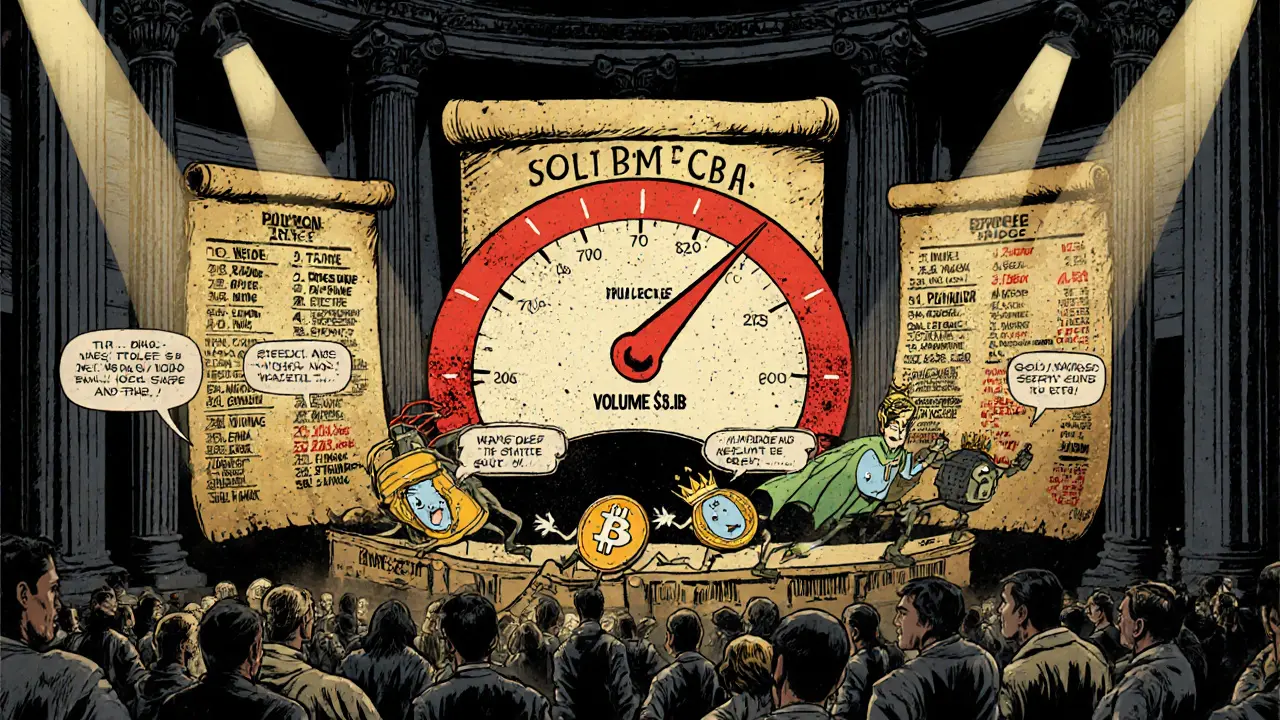
Wrapped Asset Volume Tracker
How This Data Helps You
- Identify where cross-chain liquidity is flowing
- Spot emerging bridge infrastructure trends
- Monitor DeFi protocol adoption across chains
- Anticipate market movements based on bridge upgrades
When you hear about crypto trading volume, names like Bitcoin, Ethereum, and Tether dominate the chatter. But beneath those headline makers lives a quieter class of tokens that are turning cross‑chain compatibility into a massive market force: top wrapped assets by volume. Wrapped assets let you move value from one blockchain to another, and the ones that trade the most can give you clues about where liquidity is flowing across ecosystems.
What Exactly Is a Wrapped Asset?
Wrapped Token is a digital representation of another cryptocurrency that lives on a different blockchain. The original asset is locked in a smart contract or custodial vault, and a new token is minted that mirrors its price 1:1. This "wrapper" enables the underlying asset to be used in DeFi protocols, DEXs, and other applications that aren’t native to its original chain. Common examples include Bitcoin on Ethereum (WBTC) and Ether on Binance Smart Chain (WETH). The concept boosts interoperability, reduces transaction costs, and opens up new arbitrage pathways.
Why Trading Volume Matters for Wrapped Tokens
Volume is the lifeblood of any liquid market. For wrapped assets, high volume means more users are moving value across chains, which in turn signals strong demand for cross‑chain services. Tracking the most‑traded wrappers helps investors spot where bridge infrastructure is thriving, where DeFi protocols are capitalizing on foreign liquidity, and which chains are becoming hubs for multi‑chain activity.
How We Rank Wrapped Assets by Volume
Because no single data provider publishes a dedicated wrapped‑token leaderboard, we combine several sources:
- On‑chain bridge analytics (e.g., Polygon Bridge statistics)
- Exchange volume reports that break out "wrapped" tickers (e.g., Binance, OKX)
- DeFi aggregator dashboards that list token swap volumes across chains
- Cross‑chain bridge transaction counts from projects like Wormhole, Axelar, and LayerZero
We normalize the data to 24‑hour USD volume and filter for tokens that maintain a 1:1 peg to a major asset (Bitcoin, Ether, stablecoins, etc.). The resulting list reflects the most actively traded wrappers across all major ecosystems as of October2025.
Top Wrapped Assets by 24‑Hour Trading Volume
Below are the eight wrappers that dominate cross‑chain liquidity. Numbers are rounded estimates based on the latest aggregated data.
- WBTC (Wrapped Bitcoin on Ethereum) - Approx. $2.1B
- WETH (Wrapped Ether on Binance Smart Chain) - Approx. $1.8B
- renBTC (Ren Protocol's Bitcoin wrapper on Ethereum) - Approx. $420M
- USDC.e (USDCoin on Avalanche) - Approx. $360M
- Binance‑Peg BUSD (BUSD wrapped on Binance Smart Chain) - Approx. $310M
- WMATIC (Wrapped MATIC on Ethereum) - Approx. $280M
- stETH (Lido’s liquid staking Ether on Ethereum) - Approx. $260M
- WFTM (Wrapped Fantom on Ethereum) - Approx. $210M
Comparison Table
| Asset | Underlying | Native Chain (wrapper) | Approx 24h Volume (USD) | Main Bridge/Issuer |
|---|---|---|---|---|
| WBTC | Bitcoin | Ethereum | $2.1B | WBTC DAO / RenVM |
| WETH | Ether | Binance Smart Chain | $1.8B | Binance Bridge |
| renBTC | Bitcoin | Ethereum | $420M | Ren Protocol |
| USDC.e | USDCoin | Avalanche | $360M | Circle + Avalanche Bridge |
| Binance‑Peg BUSD | BUSD | Binance Smart Chain | $310M | Binance Bridge |
| WMATIC | Polygon (MATIC) | Ethereum | $280M | Polygon Bridge |
| stETH | Ether (staked) | Ethereum | $260M | Lido Finance |
| WFTM | Fantom | Ethereum | $210M | Fantom Bridge |

Key Takeaways
- Wrapped Bitcoin (WBTC) and Wrapped Ether (WETH) together capture over $3.9B in daily trades, dwarfing all other wrappers.
- Stablecoin wrappers on high‑throughput chains (USDC.e on Avalanche, Binance‑Peg BUSD) rank in the top five, showing that traders move fiat‑backed tokens across chains for cheaper swaps.
- Bridge providers (Binance Bridge, Polygon Bridge, RenVM) act as liquidity gatekeepers; their health directly impacts wrapper volume.
- Emerging wrappers like WMATIC and WFTM illustrate growing interest in moving “layer‑1” tokens into the Ethereum DeFi pool.
- Volume spikes often align with bridge upgrades or fee reductions, so monitoring bridge announcements is a practical way to anticipate market moves.
Trends Shaping Wrapped Asset Liquidity
1. Layer‑2 Adoption: As Optimism, Arbitrum, and zkSync gain traction, we’re seeing new WETH variants (e.g., WETH‑L2) that could soon crack the top‑five list.
2. Regulatory Push on Stablecoins: Tightening rules in the U.S. have led projects to issue wrapped stablecoins on chains with more favorable compliance frameworks, boosting volumes for USDC.e and BUSD‑Peg.
3. Cross‑Chain DeFi Protocols: Platforms like Thorchain and Axelar enable direct swaps of wrapped assets without a centralized exchange, feeding additional volume into the wrappers themselves.
4. Fee Optimization: Bridges that slash gas costs (e.g., Polygon’s PoS bridge) attract massive flows, evident in WMATIC’s surge over the past quarter.
Risks and Considerations When Trading Wrapped Tokens
While wrapped assets unlock flexibility, they carry specific hazards:
- Custodial Risk: The original asset sits in a smart contract or custodial vault. Vulnerabilities in that contract could jeopardize the wrapped token.
- Bridge Centralization: Some bridges are controlled by a small team. Governance failures or malicious upgrades can freeze or burn wrappers.
- Liquidity Fragmentation: High‑volume wrappers on one chain may have thin order books on another, leading to slippage.
- Regulatory Uncertainty: Wrapped stablecoins can be caught in cross‑border regulatory sweeps, potentially leading to sudden delistings.
Always verify the audit status of the wrapper contract and keep an eye on bridge announcement channels.
How to Track Wrapped Asset Volume in Real Time
Here’s a quick workflow for staying on top of the numbers:
- Subscribe to a DeFi analytics dashboard (e.g., Dune, DefiLlama) and filter for token symbols that start with “W”.
- Set up alerts on major exchanges (Binance, Coinbase Pro) for sudden spikes in wrapped‑token trading pairs.
- Follow bridge Twitter accounts and Discord servers; they often post live volume stats after upgrades.
- Use on‑chain explorers (Etherscan, BscScan) to view contract transaction counts for each wrapper.
- Combine the on‑chain data with exchange volume feeds in a spreadsheet to calculate a weighted 24‑hour average.
With this setup you’ll spot emerging wrappers before they hit the mainstream charts.
Conclusion
Wrapped assets might not have the brand power of Bitcoin or Ethereum, but their trading volumes tell a compelling story about cross‑chain demand. WBTC and WETH dominate today, but the rise of stablecoin wrappers, layer‑2 variants, and niche bridges suggests the leaderboard will keep evolving. By understanding how these tokens work, why volume matters, and where to get reliable data, you can navigate the multi‑chain landscape with confidence.
Frequently Asked Questions
What is the difference between WBTC and renBTC?
WBTC is issued by a consortium of custodians and follows a strict audit regime, while renBTC is minted by the RenVM protocol using a decentralized network of validator nodes. Both represent Bitcoin on Ethereum, but WBTC generally enjoys higher liquidity on centralized exchanges.
Can I use wrapped assets on any blockchain?
Only if the wrapper contract has been deployed on that chain and a bridge exists to lock the underlying asset. For example, WETH is native to Ethereum but also exists on Binance Smart Chain via the Binance Bridge.
Why do stablecoin wrappers like USDC.e have high volume?
Traders move USDC to fast, low‑fee chains (like Avalanche) to swap for other tokens without paying Ethereum gas costs. The wrapped version mirrors the stablecoin’s price, so it’s a convenient way to access DeFi opportunities on cheaper networks.
How safe are the smart contracts behind wrapped tokens?
Most major wrappers have undergone multiple audits, but no contract is immune to bugs. Users should verify the latest audit reports, check for bug bounty programs, and consider the reputation of the bridge operator before locking large amounts.
Where can I see real‑time volume data for wrapped assets?
Platforms like Dune Analytics, DefiLlama, and CoinGecko’s “Derived Markets” section let you filter by token symbol. Adding exchange‑specific alerts on Binance or OKX can also give you up‑to‑the‑minute numbers.






There are 13 Comments
Cynthia Rice
Wrapped assets are the silent arteries of crypto, pumping liquidity where we least expect it.
Shaian Rawlins
It's fascinating how the ecosystem has evolved to treat wrapped tokens as essential building blocks rather than afterthoughts. When you look at the volume numbers, you can see a clear pattern of capital seeking the cheapest path across chains. This kind of cross‑chain flow fuels innovation in DeFi protocols that rely on seamless asset movement. The data in the article shows that WBTC and WETH still dominate, but newer bridges are pulling their weight fast. By keeping an eye on bridge upgrades, you can anticipate where the next liquidity surge will happen. So, staying informed isn’t just a hobby-it’s a practical strategy for anyone wanting to navigate the multi‑chain world effectively.
Miranda Co
Stop pretending wrapped tokens are just a side show; they’re the main event for real traders. If you ignore the volume stats, you’re left in the dust while others capitalize on cheap swaps. Get on board or get left behind.
mukesh chy
Oh sure, let’s all bow down to the “wrapped” hype like it’s the holy grail of finance. Meanwhile, the actual Bitcoin holders are probably rolling their eyes at the sheer absurdity of renaming the same asset. But hey, if you love watching bridge fees melt away, go ahead and worship those W‑tokens.
Amal Al.
Honestly, the sarcasm is appreciated-however, let’s not forget that bridges have become critical infrastructure; they enable real‑world use cases, liquidity provision, and arbitrage opportunities, all of which are reflected in the volume numbers-so dismissing them outright ignores the data‑driven reality! Moreover, the community benefits from robust bridges that are regularly audited and improved; this isn’t just hype, it’s evolution!!!
Matt Nguyen
While the masses chatter about “wow” volumes, only a handful truly comprehend the underlying tokenomics that drive these figures. The nuanced interplay between custodial risk and on‑chain verification demands a higher level of analytic rigor. One must scrutinize the audit trails of each wrapper to separate genuine liquidity from artificially inflated trades.
Taylor Gibbs
For anyone just getting started, think of wrapped assets as the passport that lets your crypto travel between countries. You don’t need to be a tech wizard to use them-just pick a reputable bridge and keep an eye on the fee schedule. This approach keeps things simple and safe.
Jim Griffiths
Check Dune or DefiLlama for real‑time wrapped token volume charts, then set alerts on your favorite exchange for spikes.
Twinkle Shop
The modern liquidity landscape is fundamentally contingent upon the seamless interoperability afforded by wrapped assets, which act as synthetic proxies for native assets across disparate blockchain ecosystems.
When a user locks Bitcoin in a custodial smart contract, the minted WBTC on Ethereum inherits the full market valuation of its parent while simultaneously granting access to Ethereum‑centric DeFi primitives.
This duality introduces a layer of abstraction that, while beneficial for yield farming, also compounds the risk vectors associated with smart contract vulnerabilities and bridge centralization.
From a macro‑economic perspective, the aggregated 24‑hour volume of wrapped tokens serves as a leading indicator of cross‑chain capital migration, often preceding shifts in on‑chain activity metrics such as transaction throughput and gas price volatility.
Analysts observing the surge in WMATIC and WFTM volumes can infer a growing appetite for layer‑1 assets to be re‑deployed within the high‑velocity Ethereum DeFi market, a trend that is further accelerated by fee optimization mechanisms embedded within next‑gen bridges.
Regulatory developments, particularly the tightening of stablecoin oversight in the United States, have catalyzed the emergence of wrapped stablecoins on alternative high‑throughput chains like Avalanche, thereby diluting concentration risk and fostering competitive fee structures.
The bridge architecture itself-whether it relies on federated validators as in RenVM or leverages optimistic rollup verification like in Optimism-directly influences latency, finality guarantees, and ultimately, user confidence, which is reflected in the volume heatmap.
Liquidity fragmentation remains a persistent challenge; a token that enjoys deep order books on Binance Smart Chain may suffer from thin depth on Ethereum, leading to slippage and arbitrage opportunities that sophisticated traders can exploit.
Furthermore, the symbiotic relationship between wrapped assets and cross‑chain DeFi aggregators such as Thorchain underscores the importance of protocol‑level composability, where a single swap can traverse multiple bridges in a single transaction flow.
From a risk management standpoint, custodial risk-embodied by the need to trust the underlying Vault contract-necessitates rigorous audit reviews, bug bounty participation, and community transparency reports to mitigate potential systemic failures.
The recent upgrade of the Polygon PoS bridge, which introduced batch processing and reduced gas consumption by 40 %, is a concrete example of how infrastructure improvements can precipitate immediate volume spikes, as evidenced by WMATIC’s quarterly surge.
In practice, portfolio managers should correlate wrapped token volume data with bridge health metrics, such as transaction success rates and fee reversion statistics, to construct a more resilient allocation strategy.
Data providers like Covalent and The Graph now furnish APIs that enable near‑real‑time extraction of bridge‑specific volume, facilitating automated monitoring pipelines for institutional participants.
Strategically, the integration of these data streams into quantitative models allows for predictive analytics that anticipate bridge‑driven liquidity influxes, thereby affording a competitive edge in fast‑moving markets.
Ultimately, the continued evolution of wrapped assets hinges on community trust, technological robustness, and regulatory clarity-all of which converge to shape the future trajectory of cross‑chain finance.
Greer Pitts
Yo, I’ve been watching the W‑token charts all day and man, those spikes are insane! The bridge updates are dropping like hotcakes, so you gotta stay on top or you’ll miss the gravy train. Keep your eyes peeled and your wallet ready.
stephanie lauman
While enthusiasm is commendable, it’s crucial to recognize that the apparent “spikes” may be artificially amplified by wash‑trading bots-an element the casual observer often overlooks :) A disciplined approach, grounded in audit reports and on‑chain verification, remains the only reliable path to sustainable returns.
Lurline Wiese
Can you believe some folks still think wrapped tokens are just a fad? It’s like watching an old movie and refusing to see the special effects!
Jenise Williams-Green
Honestly, the hype around wrapped assets reeks of profit‑driven opportunism that skirts the true purpose of decentralization. If you truly care about financial sovereignty, you’ll question every bridge upgrade and demand immutable, trustless solutions. Anything less is just chasing the next shiny token.
Write a comment
Your email address will not be published. Required fields are marked *